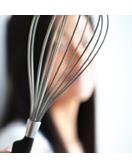Liu sha bao? It translates from 流沙包 meaning flowing custard filling buns in Chinese just like these steamed custard buns that I have made again ...
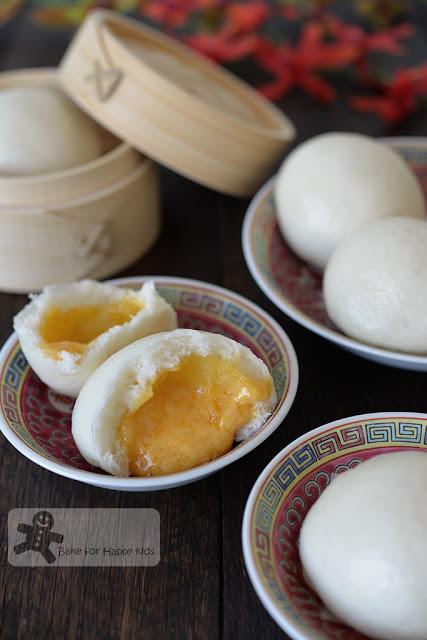
Liu Sha Bao / Chinese Molten Salted Egg Custard Steamed Buns 流沙包 Again!
Imagine holding one freshly steamed liu sha bao on your hand. Carefully, bite a nick off the bun and let the molten custard flow into your mouth. Can't have enough flowing custard filling??? Try sucking the remaining filling from the nick of the bun... and finish by eating the last bit of custard that sticks inside the bun.
Totally yummy! Totally rememberable!!! What do you think?
Let's say that my first liu sha bao recipe that I have truly tested and used is pretty ultimate!!!
Yet, the always curious me is always curious and was wondering if there is any simplified recipes that (1) makes molten custard filling with lesser number of ingredients (2) makes the steamed buns that are fluffier, whiter and more delicious (3) can make buns quicker with no proving step required.You know what? There is!
So please pardon me that this... my second Liu Sha Bao blog post is going to be naggy and lengthy! :p
Here are the recipes that I have tried...
(1) The custard filling with NO cornflour and NO coconut milk
This molten custard filling recipe originates from the book, Cooking Classics Dim Sum by Ng Lip Kah. It's almost similar to the molten custard filling (with custard powder) that I have made before but it's a simpler version with no cornflour and no coconut milk as it contains milk, more icing sugar but slightly lesser salted duck egg yolk, butter, milk powder and custard powder. Most importantly, it works!!!
How does it work? I had a closer look at both recipes and found that both recipes use a ratio of 2.8 to 3.9 part (by weight) of total dry ingredients to 1 part (by weight) of butter. Seeing this, I can't help to draw a conclusion that the ratio of total dry ingredients to butter has to be within this range in order for the steamed filling to be flowy.
I have noticed that the type and amount of liquid used to gel up all the ingredients is also equally important as I see that the previous recipe uses tablespoonful of richer coconut milk whereas this newly explored one uses teaspoonful of milk to do this gelling job. Seeing this, I strongly believe that too much water content might absorb and thicken the dry ingredients in the filling and causing it to be not flowing!
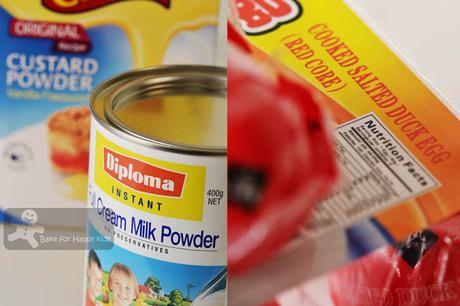
No cornflour and coconut milk are required in this simplified filling recipe.
These plus unsalted butter, icing sugar and milk are the ingredients that I used to make this simplified filling.
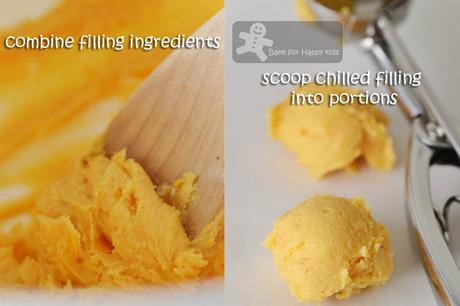
The method of preparing this filling is exactly the same as the one that I used before at here
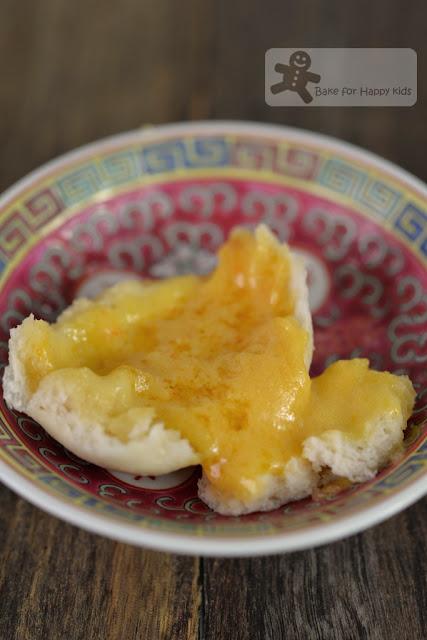
See! It works!
(2) Is there any steamed bun recipes that makes the steamed bun fluffier, whiter and more delicious?
I know this steamed bun recipe is really really really good as I have tried and tested it well enough at here, here and here and it always makes really fluffy, white and delicious buns all the time!
(3) Then, I asked myself... Is there any recipe that can make buns quicker with no proving step required?
I have found two steamed bun recipes with two different interesting composites to try...
One is also from the book, Cooking Classics Dim Sum by Ng Lip Kah which contains NO oil or shortening at all and uses potato starch!!! Due to the presence of the potato starch, the dough was a little dry when I added the minimum amount of water but became sticky after I added just enough to gather the dough! Bizarre!
Two... Just in case if this recipe fails, I'm trying another steamed bun recipe that is mostly adapted from the book, Dim Sum Inspiration by Choong Su Yin. I noticed that this recipe is almost the same as this best steamed bun recipe that I have tried before except that this one contains slightly less water, more sugar and uses shortening instead of oil. Comparing with another fantastic steamed bun recipe that I have tried, this ones uses more water and lesser shortening... I wonder if this composite works as well as others.
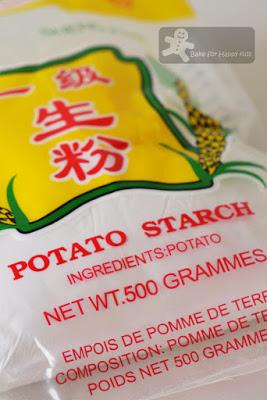
Interesting recipe:
This steamed bun recipe from the book, Cooking Classics Dim Sum by Ng Lip Kah uses potato starch!
After mixing and kneading the steamed bun dough, I always leave them to prove for at least an hour or until they double in their size but these two steamed bun recipes say that I can use them straight away after kneading them in smooth dough and this is what I did...
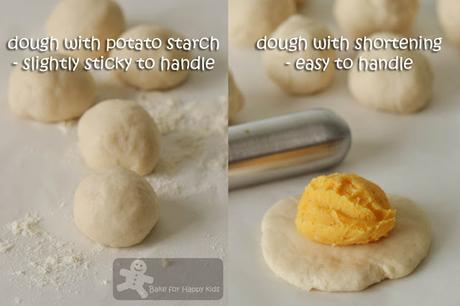
Shaping the buns with two different dough.
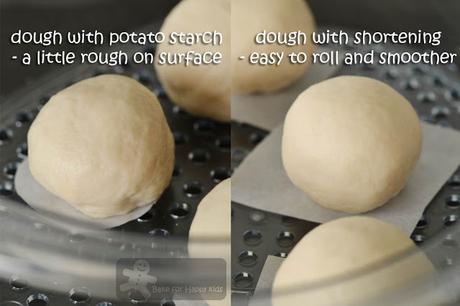
After shaping...
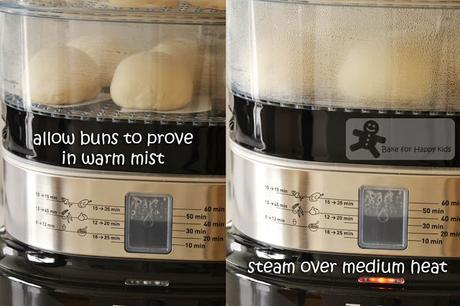
Instead of proving the dough before shaping, the buns are left to prove until they look puffy.
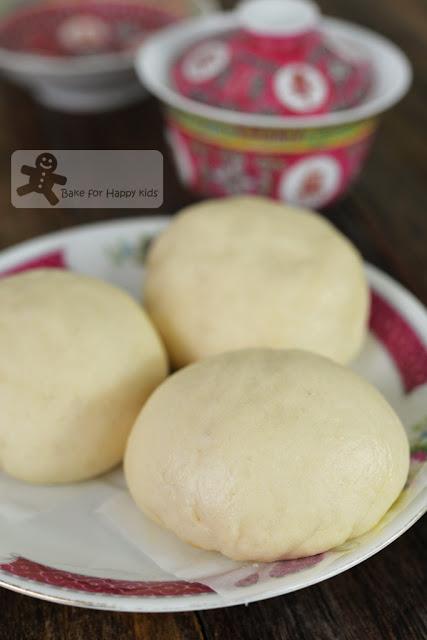
These are the custard buns made with the dough with shortening.
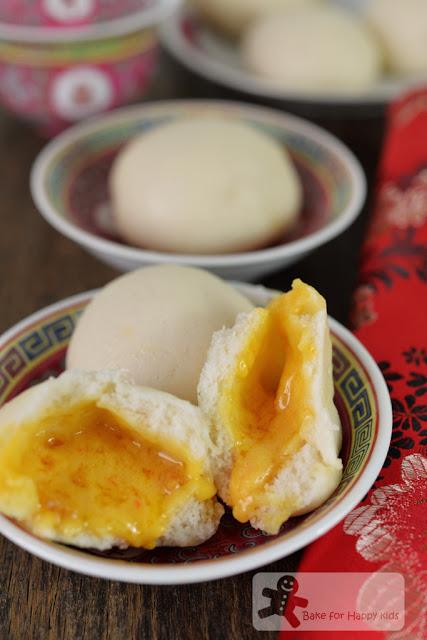
It works!
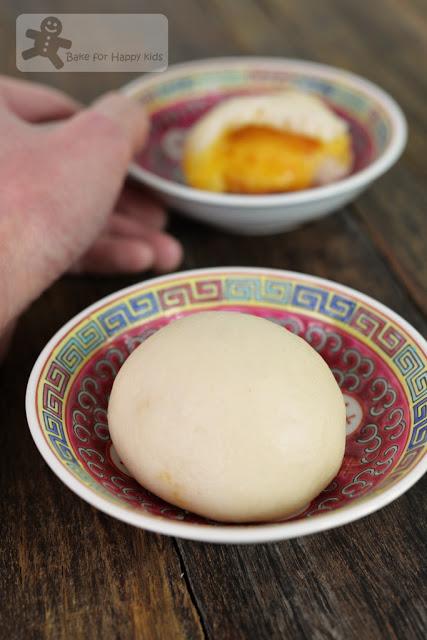
The custard buns made with the dough with potato starch.
It works too!
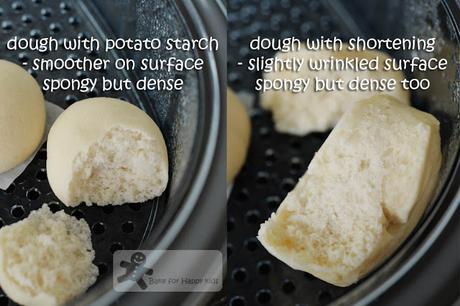
See any difference?
There was some leftover dough and so I steamed them on their own.
They turned out to be firm, dense with a gummy texture!
They are so yucky without the filling!!!
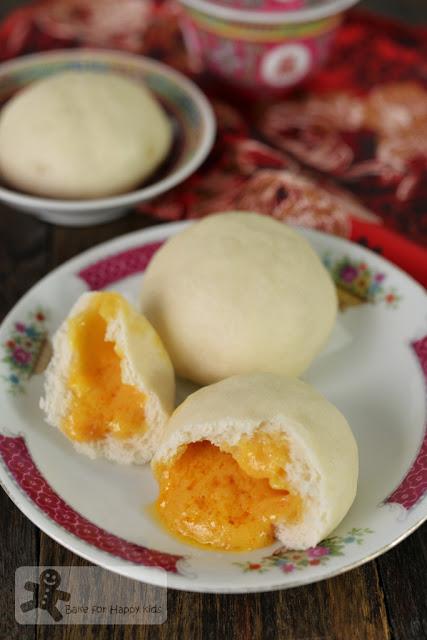
Liu sha bao with the bao recipe that doesn't require proving before shaping.
Ok with the filling but NOT nice without the filling!!!
Why?
I keep scratching my head asking myself this question... LOL!One thing that I'm pretty sure is that not proving the dough before shaping will make the dough less fluffier! Lesson learnt! I wouldn't skip any proving step before shaping the buns in the future!Any conclusion?Yes!!! I do have something to say!!! LOL!I'm happy that both molten custard filling that I have used at my previous post (with cornflour and coconut milk) and this simplified one (with milk) works!!! So which is better? Although this filling with milk seems thicker, creamier with less melting butter than the ones with coconut milk, I still like the coconut milk tiny tiny a little more because of its richer taste and coconut fragrant. Seriously, if I'm not in a fussy mood, both are equally good to me!
As for the steamed bun... Nothing beat my favorite steamed buns recipes at here and here! To me, they are invincible and unbeatable!!! LOL!Having said that, I can see the benefit of these two steamed bun recipe too, they are firm and dense like enclosed cups and can hold the molten custard filling very well making the explosion rate kind of minimal!!! Which one is better? I can't really tell. One (with shortening) is easier to handle and the other one (with potato starch) looks nicer after steaming. Both taste the same being gummy and firm. Hmmm...Speaking of custard bun explosion, I have some tips to share about steaming these buns before proceeding on to the recipe...Many readers have told me that 1) their custard fillings are not flowy 2) their steamed bun skin are wrinkly 3) their buns look squashed collapsed 4) their buns keep exploding!Beside using the right recipe, weighing the ingredients correctly and following the instructions properly, steaming the buns is critically the cause of your liu sha bao problems!Honestly, I don't really have a standard answer to tell you how to steam your buns as different steamer or steaming setup can be really different!!! All I can do is to share are these potential solutions that I have came across...If you are steaming liu sha bao for the first time, try steaming with just one bun first and test if the timing, heat and humidity that you used is right setting for you.1) To make sure that the custard fillings are flowy, you have to steam the buns long enough.2) ... but not too long until they explode - so please test the timing with one bun first!3) To minimize liu sha bun explosion, use medium low heat to steam your buns. Can't control your steaming heat??? Open your steamer lid halfway in every 15-30 secs or lift your steamer lid slightly with a chopstick to reduce the heat constantly.4) Too much steam can cause steamed bun skin to be wrinkly. To minimise this, you can wrap your steamer lid with towel to absorb the moisture or allow excess steam to escape through the small opening for less than a minute after steaming but don't do this for too long as the longer period of steaming will cause the buns to explode!5) If your buns look squashed, this means that the fillings have leaked out of the buns or the dough that you made is too wet and can't hold the shape after steaming. This has nothing to do with steaming! LOL! To minimise this, make sure that you have made the dough correctly and also the filling has to be thoroughly enclosed inside the dough.Well, I think I blah blah blah enough of liu sha bao steaming...
To conclude, I have derived my second best liu sha bao recipe which is...
Made with this simplified molten custard filling and my favorite steamed bun recipe (with proving before and after shaping)...
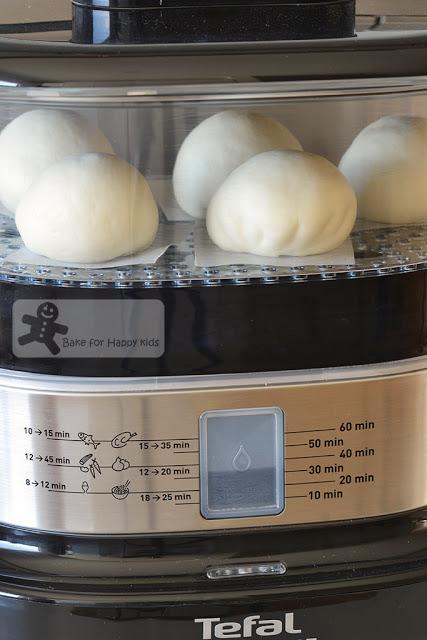
Making another batch of liu sha bao.
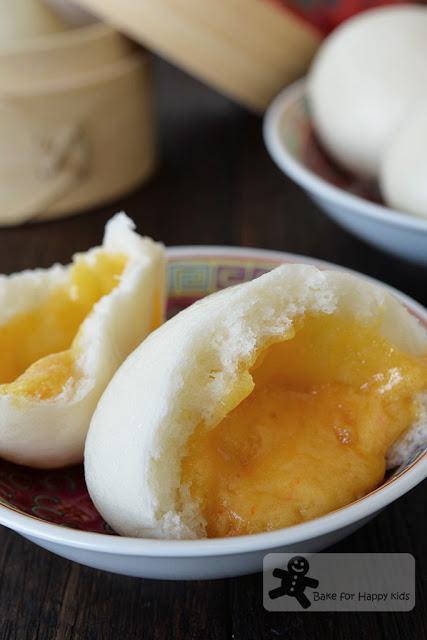
Yup! Double, Triple, Multi-confirmed that this is another good Liu Sha Bao recipe!!!
Besides this recipe, this is my another good Liu Sha Bao recipe.Makes 15 rather medium small custard buns (not too small and not too big)
Molten custard filling that is mostly adapted from the book, Cooking Classics Dim Sum by Ng Lip Kah
Makes 15 small filling portions
50g unsalted butter, soften at room temperature
70g icing sugar
2 salted duck eggs yolks*, roughly mashed with a fork to form fine crumbs
25g custard powder
25g milk powder
1 tsp milk
*2 standard sized salted duck eggs is about 35g, fully cooked, shelled and use egg yolks only
Using a wooden spoon or an electric mixer, beat butter and icing sugar together until combined. Add the remaining ingredients and mix until well-combined.
Refrigerate the custard filling until cold and firm. When firm, use a cookie scoop to scoop out and divide the custard into 15 portions. Place the custard balls on a plate or container lined with cling wrap or baking paper for easier removal, freeze it overnight with a cover or cling wrap.
Note: Personally, I don't like the steamed bun recipes from the books, Cooking Classics Dim Sum by Ng Lip Kah and Dim Sum Inspiration by Choong Su Yin because I think they are just ok!!! Sorry!
Instead, this is the steamed bun that I like the most which is adapted from here.
160ml (1/2 cup + 8 tsp) water
15ml (1 tbsp) vegetable oil, preferably something light like canola oil30g (2 tbsp) caster sugar300g Hong Kong flour (1 pack) or any low protein (7-9%) bleached flour
3/4 tsp baking powder, preferably double acting baking powder
3/4 tsp instant yeast
Place water, oil, sugar, flour, baking powder and yeast according to this order into a breadmaker and use "dough” setting to knead and prove the dough for 1 hr.
If breadmaker is not available, kneading by hand is possible. Combine flour, baking powder, yeast, sugar in a mixing bowl. Make a well in the flour mixture, add water and oil mix to form a dough. Transfer dough onto a lightly floured work surface. Knead to form an elastic and smooth dough (at least 20 mins) and then let it rise for 1 hr.
When the dough is ready, divide into 15 portions (about 30g each). Flatten the dough pieces with your hands or roll it slightly with a rolling pin and place a frozen custard filling ball in the center. Pinch up the sides of the dough to completely enclose the filling.Place each bun on each paper cup liner or a small piece of baking paper with its seam sides down. Place buns on the heat proof containers or steaming baskets that you are using to steam and allow them to rest in warm mist (with warm water at the bottom of the steamer) for 10-15 mins. If you are making the buns in warm place (like Singapore), you don't have to rest them in warm mist - Resting at room temperature with a cover for 10-15 mins will do.
Steam buns with moderate heat (do not use high heat!) for about 8-9 mins or until done. The steam timing varies if you have multiple layers of buns to steam. The layer that is closest to the direct steam will take about 8 mins to cook.
Beware! Please DO NOT use too high heat or over-steam!!! Otherwise, the custard filling will explode out of the buns. To prevent the buns from exploding, please see the above steaming tips.Leftovers can be kept in fridge or freezer with cling wrap or cover. To freeze, allow buns to cool completely at room temperature. Wrap each bun in each small freezing bag and place them in the freezer. To consume, no thawing of frozen buns is required. Just re-steam the kept buns until hot before serving.Serve immediately.
Happy SteamingPlease support me and like me at Facebook...
